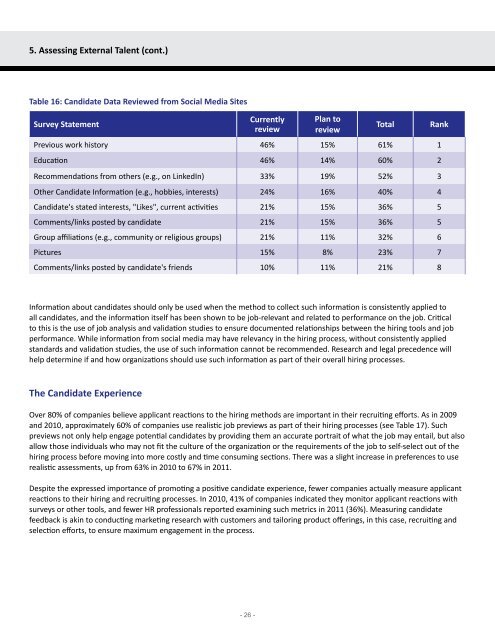Research Report
Research report
Research report
You also want an ePaper? Increase the reach of your titles
YUMPU automatically turns print PDFs into web optimized ePapers that Google loves.
5. Assessing External Talent (cont.)<br />
Table 16: Candidate Data Reviewed from Social Media Sites<br />
Survey Statement<br />
Information about candidates should only be used when the method to collect such information is consistently applied to<br />
all candidates, and the information itself has been shown to be job-relevant and related to performance on the job. Critical<br />
to this is the use of job analysis and validation studies to ensure documented relationships between the hiring tools and job<br />
performance. While information from social media may have relevancy in the hiring process, without consistently applied<br />
standards and validation studies, the use of such information cannot be recommended. <strong>Research</strong> and legal precedence will<br />
help determine if and how organizations should use such information as part of their overall hiring processes.<br />
The Candidate Experience<br />
Over 80% of companies believe applicant reactions to the hiring methods are important in their recruiting efforts. As in 2009<br />
and 2010, approximately 60% of companies use realistic job previews as part of their hiring processes (see Table 17). Such<br />
previews not only help engage potential candidates by providing them an accurate portrait of what the job may entail, but also<br />
allow those individuals who may not fit the culture of the organization or the requirements of the job to self-select out of the<br />
hiring process before moving into more costly and time consuming sections. There was a slight increase in preferences to use<br />
realistic assessments, up from 63% in 2010 to 67% in 2011.<br />
Despite the expressed importance of promoting a positive candidate experience, fewer companies actually measure applicant<br />
reactions to their hiring and recruiting processes. In 2010, 41% of companies indicated they monitor applicant reactions with<br />
surveys or other tools, and fewer HR professionals reported examining such metrics in 2011 (36%). Measuring candidate<br />
feedback is akin to conducting marketing research with customers and tailoring product offerings, in this case, recruiting and<br />
selection efforts, to ensure maximum engagement in the process.<br />
- 26 -<br />
Currently<br />
review<br />
Plan to<br />
review<br />
Total Rank<br />
Previous work history 46% 15% 61% 1<br />
Education 46% 14% 60% 2<br />
Recommendations from others (e.g., on LinkedIn) 33% 19% 52% 3<br />
Other Candidate Information (e.g., hobbies, interests) 24% 16% 40% 4<br />
Candidate's stated interests, "Likes", current activities 21% 15% 36% 5<br />
Comments/links posted by candidate 21% 15% 36% 5<br />
Group affiliations (e.g., community or religious groups) 21% 11% 32% 6<br />
Pictures 15% 8% 23% 7<br />
Comments/links posted by candidate's friends 10% 11% 21% 8



